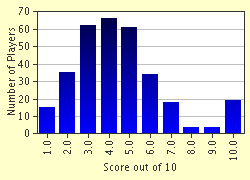Quiz Answer Key and Fun Facts
1. Outer space is, in some ways, similar to subatomic space. It's largely empty with vast distances between objects. But sometimes all that distance isn't enough to ensure that there won't be some sort of collision. On December 9, 1994, a near-Earth object (NEO) called 1994 XM1 passed within 105,000 kilometres of Earth. What was the approximate mass of this object?
2. Concentrated scientific effort has allowed us to predict how many NEOs (near Earth objects) probably exist. An NEO is defined as an asteroid or comet that, at some point, will travel close enough to Earth to pose a small potential impact risk. As of 2003, approximately half of all the large (greater than 1 kilometre in diameter) predicted NEOs have been visually identified and tracked. The total number of large NEOs that are predicted to exist is:
3. How many people worldwide are involved in the nightly search for NEOs?
4. Most people have heard of the Tunguska Event in 1908; a medium-sized NEO (near Earth object-probably about 50 metres in diameter) entered the Earth's atmosphere and detonated with massive force, releasing the power of many nuclear bombs and causing destruction over hundreds of square miles. What was unusual about this occurrence?
5. What is the approximate size an asteroid would have to be, in order for its impact to initiate a short-duration global winter?
6. The first NEO (near Earth object) was discovered in 1898 and christened "Eros". In addition to being one of the largest NEOs, it has another distinguishing characteristic - it's shaped somewhat like a:
7. What is the acronym for the most successful NEO (near Earth object)discovery project?
8. What is the approximate probability of a given person being killed by a meteorite?
9. It's impossible to predict with 100% accuracy when impacts of different magnitudes are going to take place. But we can determine approximate time-frames given that we know the frequency with which such events have occurred in the past. We can expect an impact approximately as powerful as a single nuclear detonation sometime in the next:
10. An impact on the scale of that which ended the dinosaur era could end the human era as well, if we don't spot it coming in enough time to prevent its occurrence. How much time would we need in advance to be certain of putting up our best possible defense?
Source: Author
arcturiusx
This quiz was reviewed by FunTrivia editor
crisw before going online.
Any errors found in FunTrivia content are routinely corrected through our feedback system.


